Hello from Oakland,
It’s been a few months since we last wrote, and lots has been happening! We’ve delivered (almost) all of the keyboards that had been preordered, had a couple hundred keyboards in stock, run out of stock, and started taking backorders for additional keyboards. We also have a bit of news about a travel case for the Model 01 and a mysterious teaser about our next product.
Model 01 Hardware News
Inventory
With the exception of about five folks we haven’t been able to track down and some of the folks who ordered Mahogany Model 01s, we believe we’ve now offered a Model 01 to everybody who preordered one.
As of this writing, the Model 01 is out of stock. We managed to keep keyboards in stock for almost two months, running out on August 22. The next shipment from the factory is due at our warehouse in Hong Kong within a couple weeks. The factory had previously committed to having them ready by this weekend, but told us that they’re running behind because fewer workers than expected came back from the National Day holiday. As of now, they believe that they’ll have enough units to fulfill backorders ready for inspection by the 19th and the rest of the batch done by the end of the month.
Keycap sets
This has become a big of a saga. Strap in, folks.
The factory assured us many months ago that the additional sets of keycaps they owed us (and you) would be in the mail within a few weeks. That turned out not to be the case.
The injection molding factory produced an entire run of replacement keycaps a few months ago. They were painted, UV-coated and some of them were laser engraved before being delivered to our factory for final QC. When the factory started to check the keycaps, they discovered that the paint simply wasn’t adhering to the keycaps. Numerous theories about what could possibly have gone wrong were proposed to us. Eventually, we asked the factory to confirm that the injection-molding supplier hadn’t accidentally or intentionally changed the type of plastic they were using for our keycaps. The next day, the factory confirmed to us that the problem was that the injection-molding supplier had… changed the plastic they were using to make our keycaps.
The entire production run of keycaps was destroyed at the supplier’s expense.
After that, they made the entire run again. The factory rejected that run because the keycaps had various discolorations. Ordinarily, this wouldn’t be a big deal because the keycaps were being painted. However, ordinarily, an injection molding supplier is able to injection-mold plastic without discolorations.
The entire production run of keycaps was destroyed at the supplier’s expense.
The supplier blamed the painting jigs they’d designed for the discoloration issues, so they redesigned them and tried again.
After that, they made the entire run again. The factory rejected that run because the keycaps had various discolorations. Ordinarily, this wouldn’t be a big deal because the keycaps were being painted. However, ordinarily, an injection molding supplier is able to injection-mold plastic without discolorations.
The entire production run of keycaps was destroyed at the supplier’s expense.
Author’s note: The previous paragraphs were repeated verbatim because the production problem happened twice. In total, the entire run was destroyed and remade three times, with a delay of several weeks between runs.
After that, our factory sent an engineer to babysit the production process. They watched as the injection-molding supplier cleaned out their molding machine and finally started producing workable parts.
For cost reasons, we decided to have the factory arrange shipping of keycaps directly from Shenzhen. After some fairly significant back and forth, the factory recommended a local shipping agent who was willing to handle a few thousand sets of keycaps going out to more than 30 different countries. They offered us a decent shipping rate and cautioned us that shipping this way wouldn’t get detailed tracking and could take 2-3 weeks. They told us that we had to buy insurance at what we thought was a slightly high rate of 5% of the cost of the goods. They told us that if any of the keycaps didn’t arrive in a month, the shipping agent would pay to have the keycaps remanufactured and resent. At that rate, we’d have been better off self-insuring unless more than 1 in 20 packages got lost. Given how unlikely that sounded, we were a little bit annoyed.
On August 17, the factory confirmed to us that all preordered sets of QWERTY keycaps, all blank black keycaps and about half of the preordered sets of unpainted keycaps had been mailed out.
As of this writing, not a single set of keycaps has been received.
Last Friday, our factory rep met with the shipping company, who said that it was their fault, apologized and said they would take responsibility for remanufacturing and reshipping the entire order. As best we understand it, the shipping agent taped and labeled a few thousand sets of keycaps, paid the postage on them, accidentally put them back into the master cartons they arrived in from the factory and then… misplaced them. There are so many things about this that don’t make sense, but that’s the best information we have.
After telling us that engraving was in process about six weeks ago, the factory told us they finally have all the keycap sets QC checked, packaged and ready to send to the shipping company.
Thursday, we sent email to everybody who ordered Dvorak, Colemak or Linear A keycaps to double-check your shipping addresses before the factory hands them off to the shipping company.
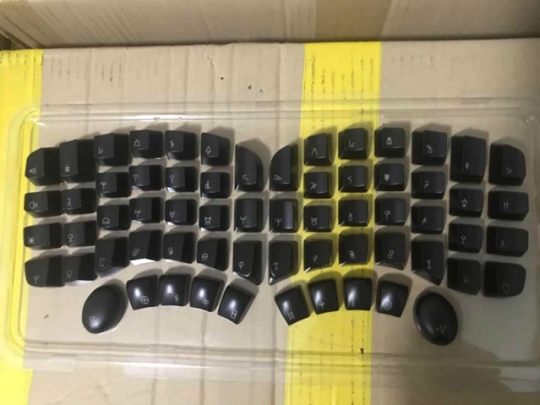
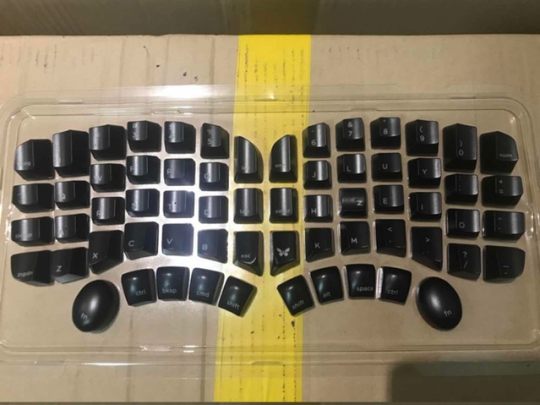
Later on Thursday, the factory sent us the final proof photos of packaged Colemak, Dvorak and Linear A keycaps packaged up and ready to go. We noticed that the “Space” label on the Colemak set was misprinted and asked the factory if that was a one-off error. Four hours later, they said they’d checked enough sets to decide that it was a widespread problem and that they were having the sets (or possibly just the Space keys) remade again. The factory says they’re going to start the injection molding today, send the new keys to the paint and laser shop on Monday, and that if all goes well, the corrected keysets will be ready in about a week and a half.
Barring another catastrophe, all the blank black, unpainted, QWERTY and Linear A sets will be delivered to the factory’s shipping partner on Tuesday for labeling and handoff to China Post. Our factory’s sales person has promised to personally oversee the handover to the postal service.
A record-breaking typhoon interrupted production for a few days, but somehow that ended up being a footnote despite looking like this:
Yeah.
Mahogany keyboards
During the Kickstarter campaign, we offered a few special edition units with a mahogany enclosure. The keyboards have the same keycaps and electronics. The only difference is a fancy enclosure. We originally expected to be able to deliver the Mahogany keyboards early, since it’d be a much smaller batch. That didn’t happen. We weren’t happy with our ability to get the fit and finish right ourselves in our home shop. Our first few wood suppliers in China weren’t willing to do a very short run with a “special” wood, and we ran into some literal translation issues with “mahogany.” In the U.S., “mahogany” can refer to several different species from the same family. In China, only Swietenia wood from South America seems to be sold as mahogany.
Oddly enough, we had multiple suppliers try to convince us to switch to Brazilian Rosewood. Brazilian Rosewood is very, very nice. They used to use it for Eames chairs. They used to use it for lots of stuff. So much stuff, in fact, that it’s now endangered and trafficking in it is a crime. At one point, we got curious and asked a supplier if they could give us paperwork for this “Brazilian Rosewood.” The next morning, they sent us full sourcing paperwork for several containers of the “Brazilian Rosewood” they wanted to sell us. The paperwork identified it as Bubinga from Africa. When we pressed them, the supplier said that in China, Bubinga is sold as Brazilian Rosewood. We tried to explain to them that they might not want to be advertising that they were trafficking in endangered wood when they weren’t, but ultimately don’t think they believed us.
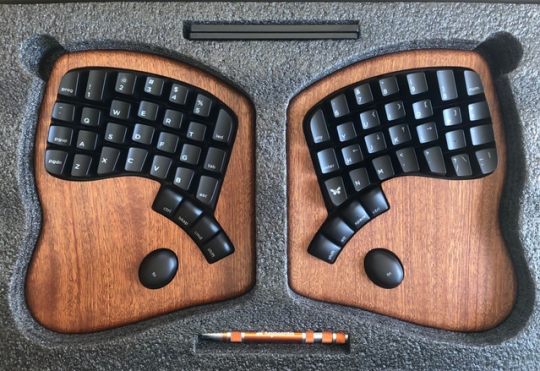
The good news is we’ve eventually managed to explain ourselves with one of our newer wood suppliers. They’ve now delivered to us fifteen absolutely gorgeous enclosures made from sapele, a beautiful African “true mahogany” wood that’s more sustainably grown than its Latin American cousins.
We’re now in the process of checking and individually numbering the Kickstarter Limited Edition sets, and are starting to reach out to the folks to whom we owe them to arrange shipping.
Replacement wooden enclosures
A handful of people were shipped keyboards in wooden enclosures that shouldn’t have gotten through our QC process (wood warped or cracked, or the finish on the wood really poorly done).
It took us a while to get good-quality enclosures in stock to do warranty replacements, but over the last month we finally got there. Our newest wood supplier delivered a batch of good-quality enclosures to us in the U.S., and we’ve been checking them and boxing them up. In general, we think they’re amongst the nicest enclosures we’ve seen. We’ll be continuing to work with this supplier going forward.
We believe we’ve reached out to everyone who has told us they need a replacement enclosure. In case you haven’t gotten back to us yet: if we owe you a warranty replacement enclosure, we need to double-check your shipping addresses and make sure we’ve correctly captured what went wrong with your current enclosure. If you’re expecting a replacement enclosure, please fill out this Google Form:
https://goo.gl/forms/URtfl4J3scPReR2m1
Since we’re collecting photos, Google requires a google account to fill in that form. If you don’t have a Google account, this form is the same, minus the “send us a picture” question:
If you use that second form, we may need to check in with you to confirm the issue before sending the replacement.
Join us on Discord
Over the past few months, the Keyboardio IRC channel, like much of the Freenode IRC network, has been overrun by spammers, making the channel almost completely unusable. Consequently, we’ve moved real-time discussion over to Discord. If you’re not familiar with Discord, you can think of it as “Slack for communities”, with a historical focus on gamers. It has a mobile UI, as well as pretty, modern GUI clients for desktop and mobile operating systems.
Discord is the right place for real-time chat about Keyboardio, Kaleidoscope, and the Model 01. If you’d like to join us on Discord, this link will let you sign up: https://discord.gg/4az77sf
For non-real-time chat with other Keyboardio fans, the best place is: http://community.keyboard.io
While we do our best to help out with Keyboardio-related issues anywhere you can find us, our official support channel is still help@keyboard.io.
Software and firmware
Kaleidoscope
The past few months have seen a fair amount of work on Kaleidoscope. For us, the biggest is that we’ve finally moved to the new plugin system designed by noseglasses. The “exciting” thing about the plugin system is that it’s now much easier for Kaleidoscope plugins to do more stuff and to use fewer of the controller’s limited resources while doing them. This means that Kaleidoscope can run just a bit faster and more efficiently and that you now have a more free space on the microcontroller for layouts, LED effects, and things like that.
This change did require us to rejigger how Model 01 firmware “sketches” work. We’ve tried to include good error messages about what you need to do as you update your firmware and have posted additional details on the forums. If you run into trouble, please don’t hesitate to reach out to us at help@keyboard.io.
We’ve squashed dozens of bugs and made numerous other changes and improvements under the hood since the last release of Kaleidoscope, too. In particular, we believe we’ve solved issues some folks were seeing when pressing and releasing bracket keys quickly, as well as a bunch of numpad and BIOS interaction issues.
If you want to switch to the new version of the firmware, you can use the Arduino IDE to install it. Follow the instructions here: https://github.com/keyboardio/Kaleidoscope/wiki/Install-Arduino-support-on-a-Mac and select “v1.92-beta” when installing Kaleidoscope.
The next thing coming down the line for Kaleidoscope is the ability to update your keyboard layout without having to compile firmware or ‘flash’ the keyboard yourself.
Chrysalis
The desktop app that you’ll use to customize your Model 01 is called Chrysalis.
The first version of Chrysalis was mostly complete over a year ago, but it was both brittle and written in…. Clojurescript, which isn’t widely used. Over the summer, we ended up making the decision to start from scratch. Throwing away something that’s close to working is never fun, but it had become clear that Chrysalis would always be hard to build unless we started over, building a React app in an Electron shell.
algernon and Jesse (but mostly algernon) have just updated Kaleidoscope’s support for storing key layouts in EEPROM. (EEPROM is essentially a tiny, tiny 1000 byte SSD inside the keyboard.) At the same time, algernon has rebuilt Focus, the serial control protocol for Kaleidoscope. (Focus is the bit that lets a program on your computer talk to the keyboard.) These two bits were the last of the code that needs to run on the keyboard to support Chrysalis.
The new version of Chrysalis lives at https://github.com/keyboardio/chrysalis-bundle-keyboardio. As of now, it starts up, detects a keyboard and can read and write keymaps. It’s not at the point where it’s pretty or user friendly, but it’s finally a solid base to build on top of.
At the same time, Simon-Claudius has been working with the folks at Dygma to prototype what a version of Chrysalis themed for their keyboard, the Raise, might look like. You can see their demo video here.
We’re hoping to be able to release a first working alpha of Chrysalis in the next couple months.
Software ports
Since we last wrote, Kaleidoscope has been 'ported’ to run on a few keyboards we didn’t create. If you have an Ergodox EZ or an Atreus by Technomancy and have Kaleidoscope 1.92 or later installed in the Arduino IDE, you should be able to select your keyboard in the “Boards” menu and flash Kaleidoscope onto your keyboard. We’re not currently able to provide commercial support for Kaleidoscope on hardware we didn’t make, but if you’re interested in the details of the ports, you can find them on GitHub for both the ErgoDox EZ and Atreus.
If you’re interested in porting Kaleidoscope to another keyboard, join us in #kaleidoscope-dev on Discord and we’d be thrilled to talk about it.
Kaleidoscope is, of course, not the only opensource keyboard firmware out there. Another popular and featureful option is called QMK. The QMK project has wide hardware support, but somewhat different goals than Kaleidoscope. Last month, James Laird-Wah added support for the Model 01 to QMK. You can read more about it here: https://community.keyboard.io/t/qmk-ported-to-model01/2015
Kaleidoscope Plugins
In the past few months, we’ve seen a few new community-created Kaleidoscope Plugins
Kevin Riggle created a “fire” LED effect for the Model 01 based on Selene Scriven’s Wavepool effect. If you’d like to add the Fire effect to your keyboard, you can grab the source code here: https://github.com/kevinr/Kaleidoscope-LED-Fire
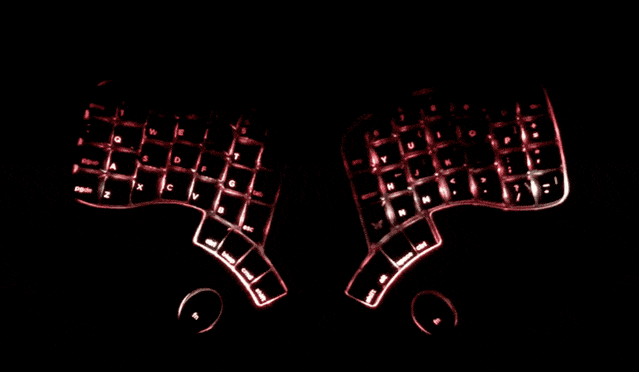
In the past couple months, we’ve seen two completely different approaches to adding Emoji support to Kaleidoscope. The first, from Burke Libbey, is a technique for creating a Slack-specific Emoji keymap layer using Kaleidoscope Macros. You can find Burke’s implementation here: https://github.com/burke/Model01-Firmware/blob/master/Model01-Firmware.ino
Jochen Pfeiffer went in a slightly different direction. Building on Kaleidoscope’s core Unicode support, he created Kaleidoscope-Emoji, a plugin that makes it easier to type Emoji into any app. You can find his plugin here: https://github.com/jjochen/Kaleidoscope-Emoji
Future Keyboardio products
Why we stopped selling “loud-click” Model 01s.
We recently stopped offering the “loud-click” version of the Model 01. A few folks have asked us whether we expect to stock them again in the future. As of now, we don’t expect to stock a loud-click version of the Model 01 again.
The reason we made the (surprisingly difficult decision) to discontinue the loud-click Model 01 was that a significant minority of the folks who got them reported that they found some keys hard to press. Initially, we couldn’t reproduce the problem folks were describing, but eventually we figured out what was going on using our handy-dandy digital force meter.
After we completed the design of the Model 01, our keyswitch vendor redesigned their switches to reduce what’s called “wobble.” The stems of classic Matias switches have a fair amount of back-and-forth play as they’re pressed down. Matias figured out a way to tighten up the keyswitch tolerances to reduce wobble and to provide what most folks say is a cleaner feeling keyswitch. On most keyboards, this worked out just great. On the Model 01, however, it worked out less great. Because on a Model 01 you are not moving your hands as much as on a traditional layout, some people’s hands end up hitting the keyswitch at a bit of an angle, which causes the new sliders to bind against the edge of the switch and the clickleaf.
Once we understood the theory of what was going wrong, we were able to measure the increased force of hitting a loud-click Matias switch at an off-angle. Instead of requiring about 55 grams of force to press, the required pressure spiked to over 100 grams. (The quiet-click switches have a slightly different design, which is largely immune to this issue.) We tried a bunch of lubricants. None made any significant difference. We discussed the issue with Matias. As of now, their best solution would be a redesign of the Model 01 to rotate all of the keyswitches 90 degrees. This issue is something we’ll keep in mind when we eventually revise the Model 01. Unfortunately, the change suggested by Matias would require new circuit boards, new aluminum keyplates, and new keycap tooling; this makes it cost prohibitive for us to do just for the sake of offering loud keyswitches.
Travel cases
One of the most frequent questions we get about accessories for the Model 01 is whether there’s a travel case we recommend for the Model 01. Until now, the best answers have included laptop cases or keeping one Model 01 at home and another at work.
We’re pleased to report that we’ve completed the design of the Model 01 travel case. Our manufacturing partner (who have nothing whatsoever to do with our keyboard factory) expects to finish assembly of the first batch of cases by the end of October. That means that it’s time for us to start selling the new case. We’re planning to run a “quickstarter” (a short 3 week Kickstarter campaign) to sell the first batch cases. At some point after that, we’ll make them available from https://shop.keyboard.io.
As of now, we’re planning to sell the case for about $35 + shipping from our Hong Kong warehouse.
Before we launch the campaign, we need to take some nice pictures of the final sample, record a video and double check our shipping pricing. To tide you over, here are a couple of quick cameraphone pictures:

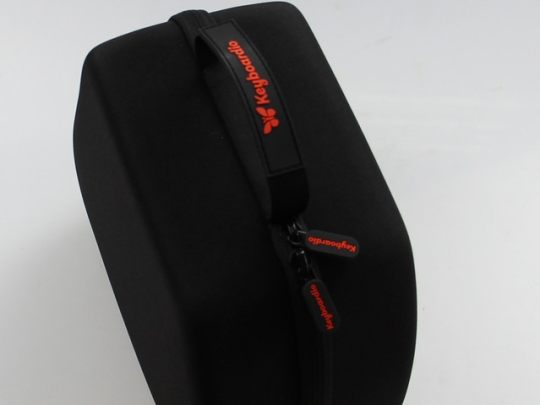
We’ll send a short email update or two when the Quickstarter launches.
The next keyboard
We know what keyboard we’re going to make next, though we aren’t quite ready to show the world. Some aspects of the design have been kicking around in our heads for the past couple years, and some early prototypes have been collecting dust for almost as long. However, as we’ve finally gotten to turn some attention to the new keyboard, things have been coming together nicely over the past month.
It’s not so much a successor to the Model 01 as a keyboard that fits in a slightly different niche. You may even want both :)
We’ve been posting work-in-progress teasers about the industrial design to Twitter. This is what it might look like with the top cover on:
After we do a little bit more design and testing, it’ll be time for Jesse to get back on a plane to Shenzhen to visit potential manufacturing partners. Once we’re all set to make the keyboard, it’ll be time to spin up the Kickstarter hype machine again.
<3 j+k
